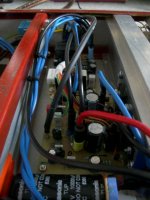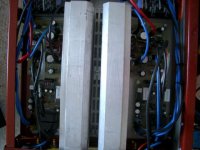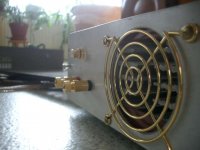Hello...
I have changed those zeners but I have still some buzzing or humming.
1st picture is measured after main capacitors plus line (wire).
Ripple is quite normal I guess so... or is it? About 300mV Peak-To-Peak.
X-axis: 100mV/div and Y-axis: 2ms/div
I have changed those zeners but I have still some buzzing or humming.
1st picture is measured after main capacitors plus line (wire).
Ripple is quite normal I guess so... or is it? About 300mV Peak-To-Peak.
X-axis: 100mV/div and Y-axis: 2ms/div
Attachments
But this second picture is quite odd....
This is measured from output when input was short circuit.
Little test speaker was connected to output.
X-axis: 50mV/div and Y-axis: 2ms/div
Where those (100Hz) peaks come from?
(pictures quality is not so good because those was taken using mobile.... as you can see that from reflection )
)
This is measured from output when input was short circuit.
Little test speaker was connected to output.
X-axis: 50mV/div and Y-axis: 2ms/div
Where those (100Hz) peaks come from?

(pictures quality is not so good because those was taken using mobile.... as you can see that from reflection
Attachments
The 300mV ripple seems OK to me.
How is your set up bias current at the moment?
The 100Hz peaks gotta come from the power supply but shouldn´t be nowhere near that big.
Maybe your power supply is too near to the audio circuitry in places?
Make a permament connection from output to oscilloscope and try to move cables around a bit and see if the picture changes.
How is your set up bias current at the moment?
The 100Hz peaks gotta come from the power supply but shouldn´t be nowhere near that big.
Maybe your power supply is too near to the audio circuitry in places?
Make a permament connection from output to oscilloscope and try to move cables around a bit and see if the picture changes.
I´m using one rectifier in the PS as described in the article.
I had to move the transformer in all of my amps to minimize PS hum.
Do you use the boards from Elektor?
If so you could connect your speaker ground directly to star ground and not via the PCB. (I still haven´t done it but this should improve it as well)
As Upupa mentioned it could be input grounding as well.
I cheated a little on that one and connected the audio input ground via 10Ohms resistor to amp ground.
Cheers
Jens
I had to move the transformer in all of my amps to minimize PS hum.
Do you use the boards from Elektor?
If so you could connect your speaker ground directly to star ground and not via the PCB. (I still haven´t done it but this should improve it as well)
As Upupa mentioned it could be input grounding as well.
I cheated a little on that one and connected the audio input ground via 10Ohms resistor to amp ground.

Cheers
Jens
hello...
Upupa Epops:
You mean ground from wall socket. I dont have connected that to main capacitors center piece. Its only connected to chassis.
So this might be reason.... lets try this next.
Hi Joensd.
I use diy PCB boards.... similar layout as Elektor have.
You said that you have connect that audio input ground to amp ground via 10ohm. Is that amp ground same point as star point?
So you have disconnect that audio input ground from amplifier board (that jumper wire)???? Or how?
Upupa Epops:
You mean ground from wall socket. I dont have connected that to main capacitors center piece. Its only connected to chassis.
So this might be reason.... lets try this next.
Hi Joensd.
I use diy PCB boards.... similar layout as Elektor have.
You said that you have connect that audio input ground to amp ground via 10ohm. Is that amp ground same point as star point?
So you have disconnect that audio input ground from amplifier board (that jumper wire)???? Or how?
Forgot to say you should properly earth your chassis first before trying anything else. Maybe this gets rid of all hum.
There are many solutions : resistor, NTC, bridge rectifier or combination of all of them.
Look HERE for some information.
The ZenV4 for example uses bridge rectifier, Aleph3 just NTC.
Cheers
Jens
There are many solutions : resistor, NTC, bridge rectifier or combination of all of them.
Look HERE for some information.
The ZenV4 for example uses bridge rectifier, Aleph3 just NTC.
Cheers
Jens
Now I have changed those zeners... so no clipping sound any more... thanks to you Joensd.
And that hum problem....

 <-- me
<-- me
I can only blame myself.
Hum occurs when Crescendo was connected to my Yamaha amplifier which one I use for pre-amplifier. Yamaha was connected also to VCR and VCR connected to by antenna cable to antenna wall socket. When I disconnect antenna cable from wall socket, hum disappears.
Not totally, but it so quiet it can be heard only about 20cm from speakers (about 8 inch). It won't does not matter to me.
Amplifier still does not exist one starpoint so there is still one problem. When I connect only one RCA -cable from Yamaha (preamp) to Crescendo's left channel there is only that quiet hum. If I change that RCA to right channel -> still that same quiet hum. But when I connect both RCAs, hum or buzz increases quite much. So is that "only one starpoint" scheme only cure for this?
Because those "tiny" heatsinks, amplifier is hot after ½ hour listening. So I will make new case for it on next summer vacation . This case will be good for preamp or some other amplifier which does not get so hot.
. This case will be good for preamp or some other amplifier which does not get so hot.
Face plate is not ready so now final pictures yet.

And that hum problem....

 <-- me
<-- meI can only blame myself.
Hum occurs when Crescendo was connected to my Yamaha amplifier which one I use for pre-amplifier. Yamaha was connected also to VCR and VCR connected to by antenna cable to antenna wall socket. When I disconnect antenna cable from wall socket, hum disappears.
Not totally, but it so quiet it can be heard only about 20cm from speakers (about 8 inch). It won't does not matter to me.
Amplifier still does not exist one starpoint so there is still one problem. When I connect only one RCA -cable from Yamaha (preamp) to Crescendo's left channel there is only that quiet hum. If I change that RCA to right channel -> still that same quiet hum. But when I connect both RCAs, hum or buzz increases quite much. So is that "only one starpoint" scheme only cure for this?
Because those "tiny" heatsinks, amplifier is hot after ½ hour listening. So I will make new case for it on next summer vacation
Face plate is not ready so now final pictures yet.

Attachments
Hum
It is voltage difference between "Earth" in your mains and "ground" in the place of your house, because all antena must be grounded. In galvanic connection of both potencials between flow compensation current (sorry, I dont know correct english word ), which makes hum on your equipment. Help is easy, you must galvanic disconnect your antena. This thing you can buy in nearest shop where sales antenen, or you can do it yourself - you must connect both conductors ( midddle and shielding )across capacitors - middle about 100 pF and shielding about 1000 pF, both ceramic for 500 v.
It is voltage difference between "Earth" in your mains and "ground" in the place of your house, because all antena must be grounded. In galvanic connection of both potencials between flow compensation current (sorry, I dont know correct english word ), which makes hum on your equipment. Help is easy, you must galvanic disconnect your antena. This thing you can buy in nearest shop where sales antenen, or you can do it yourself - you must connect both conductors ( midddle and shielding )across capacitors - middle about 100 pF and shielding about 1000 pF, both ceramic for 500 v.
Hi Eccu,
glad to see you´re getting forward.
What about a little fan that blows into the heatsinks.
They look just perfect for it, don´t they?
Ýou could use some 12V-fans and run them between 6-9V to lower noise from them.
They´ll still increase efficiency substantially.
Give it a try.
Cheers
Jens
glad to see you´re getting forward.
What about a little fan that blows into the heatsinks.
They look just perfect for it, don´t they?
Ýou could use some 12V-fans and run them between 6-9V to lower noise from them.
They´ll still increase efficiency substantially.
Give it a try.
Cheers
Jens
Hello....
After couple weeks, I have now time to play with my Crescendo project.
Well.... because I want make this easy to me....
So is there any disadvantages if first disconnect right channel input ground connector from amplifier board and then I connect that right channel input socket ground connector to left channel input socket ground connector by short wire?
So both channels ground connection goes thru left channel amplfier board to main capasitors center plate (zero state).
I ask this because this will reduce hum when both inputs are connected.
After couple weeks, I have now time to play with my Crescendo project.
Well.... because I want make this easy to me....
So is there any disadvantages if first disconnect right channel input ground connector from amplifier board and then I connect that right channel input socket ground connector to left channel input socket ground connector by short wire?
So both channels ground connection goes thru left channel amplfier board to main capasitors center plate (zero state).
I ask this because this will reduce hum when both inputs are connected.
Too many ground connectors in one sentence. It won´t work!So is there any disadvantages if first disconnect right channel input ground connector from amplifier board and then I connect that right channel input socket ground connector to left channel input socket ground connector by short wire?
Seriously, you might think separate and direct connections to star ground are better but it may have been the originally longer grounding wire from the right channel that picked up some PSU noise. I´d say go for it as it seems to solve everything.
Do you have a nice picture from the top where you can see all the cabling, that might help others for more and maybe better suggestions.
Send some pics and have fun with the amp.
Cheers
Jens
- Status
- This old topic is closed. If you want to reopen this topic, contact a moderator using the "Report Post" button.
- Home
- Amplifiers
- Solid State
- Still some problems with Crescendo. Oscillation or what?
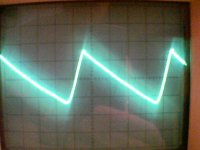
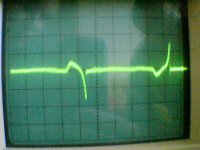
 I must go to bed now.
I must go to bed now.